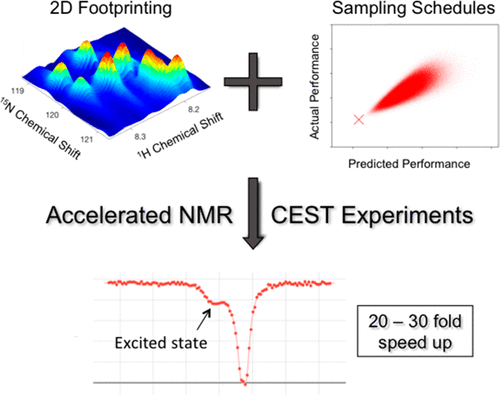当前位置:
X-MOL 学术
›
J. Am. Chem. Soc.
›
论文详情
Our official English website, www.x-mol.net, welcomes your
feedback! (Note: you will need to create a separate account there.)
Extreme Non-Uniform Sampling for Protein NMR Dynamics Studies in Minimal Time
Journal of the American Chemical Society ( IF 14.4 ) Pub Date : 2019-09-27 , DOI: 10.1021/jacs.9b08032
Gregory Jameson 1, 2 , Alexandar L Hansen 3 , Dawei Li 3 , Lei Bruschweiler-Li 3 , Rafael Brüschweiler 1, 2, 3, 4
Journal of the American Chemical Society ( IF 14.4 ) Pub Date : 2019-09-27 , DOI: 10.1021/jacs.9b08032
Gregory Jameson 1, 2 , Alexandar L Hansen 3 , Dawei Li 3 , Lei Bruschweiler-Li 3 , Rafael Brüschweiler 1, 2, 3, 4
Affiliation

|
NMR spectroscopy is an extraordinarily rich source of quantitative dynamics of proteins in solution using spin relaxation or Chemical Exchange Saturation Transfer (CEST) experiments. However, 15N-CEST measurements require prolonged multidimensional, so-called pseudo-3D HSQC experiments where the pseudo dimension is a radio-frequency offset Δω of a weak 15N saturation field. Non-uniform sampling (NUS) approaches have the potential to significantly speed up these measurements, but they also carry the risk of introducing serious artifacts and the systematic optimization of non-uniform sampling schedules has remained elusive. It is demonstrated here how this challenge can be addressed by using fitted cross-peaks of a reference 2D HSQC experiment as footprints, which are subsequently used to reconstruct cross-peak amplitudes of a pseudo-3D dataset as a function of Δω by a linear least-squares fit. It is shown for protein Im7 how the approach can yield highly accurate CEST profiles based on an absolutely minimally sampled (AMS) dataset allowing a speed-up of a factor 20 - 30. Spectrum-specific optimized non-uniform sampling (SONUS) schemes based on the Cramer-Rao lower bound metric were critical to achieve such a performance, revealing also more general properties of optimal sampling schedules. This is the first systematic exploration and optimization of NUS schedules for the dramatic speed-up of quantitative multidimensional NMR measurements that minimize unwanted errors.
中文翻译:

在最短的时间内进行蛋白质 NMR 动力学研究的极端非均匀采样
NMR 光谱是使用自旋弛豫或化学交换饱和转移 (CEST) 实验获得溶液中蛋白质定量动力学的极其丰富的来源。然而,15N-CEST 测量需要长时间的多维,即所谓的伪 3D HSQC 实验,其中伪维是弱 15N 饱和场的射频偏移 Δω。非均匀采样 (NUS) 方法有可能显着加快这些测量速度,但它们也存在引入严重伪影的风险,并且非均匀采样计划的系统优化仍然难以实现。这里展示了如何通过使用参考 2D HSQC 实验的拟合交叉峰作为足迹来解决这一挑战,随后用于通过线性最小二乘拟合重建伪 3D 数据集的跨峰振幅作为 Δω 的函数。它展示了蛋白质 Im7 如何基于绝对最小采样 (AMS) 数据集生成高度准确的 CEST 配置文件,允许加速因子 20 - 30。基于特定频谱的优化非均匀采样 (SONUS) 方案Cramer-Rao 下限度量对于实现这种性能至关重要,同时也揭示了最佳采样计划的更一般属性。这是 NUS 计划的第一次系统探索和优化,用于显着加快定量多维 NMR 测量,从而最大限度地减少不必要的错误。它显示了蛋白质 Im7 如何基于绝对最小采样 (AMS) 数据集生成高度准确的 CEST 配置文件,允许加速因子 20 - 30。基于特定频谱的优化非均匀采样 (SONUS) 方案Cramer-Rao 下限度量对于实现这种性能至关重要,同时也揭示了最佳采样计划的更一般属性。这是 NUS 计划的第一次系统探索和优化,用于显着加快定量多维 NMR 测量,从而最大限度地减少不必要的错误。它显示了蛋白质 Im7 如何基于绝对最小采样 (AMS) 数据集生成高度准确的 CEST 配置文件,允许加速因子 20 - 30。基于特定频谱的优化非均匀采样 (SONUS) 方案Cramer-Rao 下限度量对于实现这种性能至关重要,同时也揭示了最佳采样计划的更一般属性。这是 NUS 计划的第一次系统探索和优化,用于显着加快定量多维 NMR 测量,从而最大限度地减少不必要的错误。还揭示了最佳采样计划的更一般属性。这是 NUS 计划的第一次系统探索和优化,用于显着加快定量多维 NMR 测量,从而最大限度地减少不必要的错误。还揭示了最佳采样计划的更一般属性。这是 NUS 计划的第一次系统探索和优化,用于显着加快定量多维 NMR 测量,从而最大限度地减少不必要的错误。
更新日期:2019-09-27
中文翻译:

在最短的时间内进行蛋白质 NMR 动力学研究的极端非均匀采样
NMR 光谱是使用自旋弛豫或化学交换饱和转移 (CEST) 实验获得溶液中蛋白质定量动力学的极其丰富的来源。然而,15N-CEST 测量需要长时间的多维,即所谓的伪 3D HSQC 实验,其中伪维是弱 15N 饱和场的射频偏移 Δω。非均匀采样 (NUS) 方法有可能显着加快这些测量速度,但它们也存在引入严重伪影的风险,并且非均匀采样计划的系统优化仍然难以实现。这里展示了如何通过使用参考 2D HSQC 实验的拟合交叉峰作为足迹来解决这一挑战,随后用于通过线性最小二乘拟合重建伪 3D 数据集的跨峰振幅作为 Δω 的函数。它展示了蛋白质 Im7 如何基于绝对最小采样 (AMS) 数据集生成高度准确的 CEST 配置文件,允许加速因子 20 - 30。基于特定频谱的优化非均匀采样 (SONUS) 方案Cramer-Rao 下限度量对于实现这种性能至关重要,同时也揭示了最佳采样计划的更一般属性。这是 NUS 计划的第一次系统探索和优化,用于显着加快定量多维 NMR 测量,从而最大限度地减少不必要的错误。它显示了蛋白质 Im7 如何基于绝对最小采样 (AMS) 数据集生成高度准确的 CEST 配置文件,允许加速因子 20 - 30。基于特定频谱的优化非均匀采样 (SONUS) 方案Cramer-Rao 下限度量对于实现这种性能至关重要,同时也揭示了最佳采样计划的更一般属性。这是 NUS 计划的第一次系统探索和优化,用于显着加快定量多维 NMR 测量,从而最大限度地减少不必要的错误。它显示了蛋白质 Im7 如何基于绝对最小采样 (AMS) 数据集生成高度准确的 CEST 配置文件,允许加速因子 20 - 30。基于特定频谱的优化非均匀采样 (SONUS) 方案Cramer-Rao 下限度量对于实现这种性能至关重要,同时也揭示了最佳采样计划的更一般属性。这是 NUS 计划的第一次系统探索和优化,用于显着加快定量多维 NMR 测量,从而最大限度地减少不必要的错误。还揭示了最佳采样计划的更一般属性。这是 NUS 计划的第一次系统探索和优化,用于显着加快定量多维 NMR 测量,从而最大限度地减少不必要的错误。还揭示了最佳采样计划的更一般属性。这是 NUS 计划的第一次系统探索和优化,用于显着加快定量多维 NMR 测量,从而最大限度地减少不必要的错误。

































 京公网安备 11010802027423号
京公网安备 11010802027423号